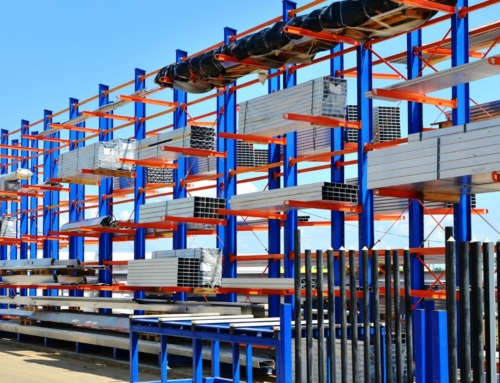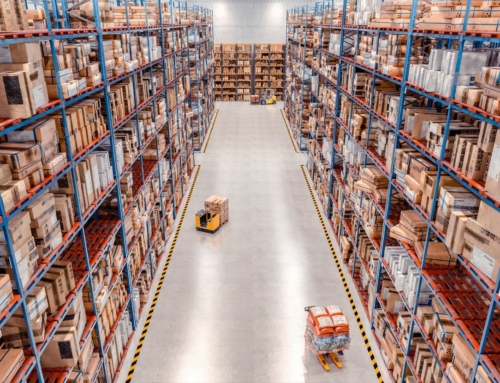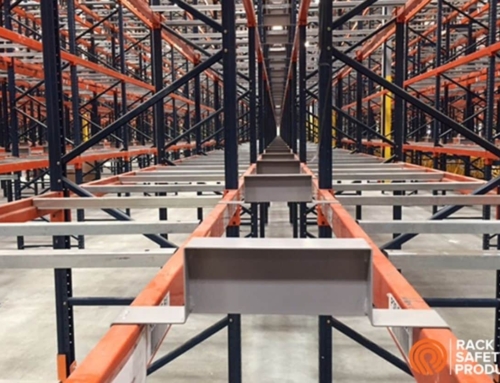Knowing the six different types of warehouse pallet racking systems can help you get your warehouse efficiency to where it needs to be. Without further ado, here are the pallet racking systems that are most likely to be beneficial to your operations!
Selective Pallet Racking Systems
Selective pallet rack systems are low-cost options for organizing products and getting pallets off the ground.
The most common type of warehouse storage and pallet rack system is selective pallet racks. They have the most affordable design as well as the broadest assortment of sizes and accessories for customizing your warehouse storage application. They’re designed to transfer pallets off the warehouse floor and into a racking system, allowing for rapid storage or unloading. Using selective pallet rack systems helps you to make the most of your warehouse floor space while also managing worker time effectively.
Consider a large bookshelf system to get a sense of how selective rack systems work. The beam levels on selective storage racks can be changed to find the right height for your load, or the complete system can be reconfigured for new or different sized pallets. This adaptability enables you to personalize and maximize storage space within racking systems.
Drive-In Pallet Racking Systems
Drive-in pallet rack systems make the most of your warehouse space by allowing you to store identical products or SKUs in high-density storage.
In your warehouse, drive-in rack systems provide maximum-density storage of related products and pallets. Because drive-in rack systems are designed for storing large quantities of similar products with the same entry and departure points for each bay or rack, they eliminate aisles in warehouses. Drive-in rack systems enable maximum-density storage since they are forklift accessible, and merchandise or pallets can be stacked in lanes up to six or more positions deep on the rack.
To place a pallet onto the back of the rack, a forklift enters the racking from one side. The pallets are then loaded in from the front to the back, providing more depth and up to three times the storage capacity of selective pallet racking. As a result, the cost of storage per pallet and per square foot is cheaper.
Push Back Pallet Racking Systems
Pallets are loaded from the front onto a nested cart system that slides on inclined rails in push back pallet racks, which are high-density storage options.
Push back rack systems are meant to store items in a dense manner without requiring First-in-First-out retrieval. Pallet racks that load pallets from the front into a nested cart system that slides on inclined rails are known as push back pallet racks.
A push back rack system is ideal for storing many product lines or SKUs in high-density storage. This product features a maintenance-free design with increased selectivity. A pallet is placed on a free rolling cart and pushed back into the system each time another pallet is loaded onto the system in a push back system. There are two, three, four, five, and six-deep cart configurations available. A push back pallet rack is substantially faster to load and unload than a comparable drive-in rack since the pallets glide down to the aisle position.
Pallet Flow Racking Systems
Using gravity rollers, a pallet is placed on the “loading” side and then moved to the “picking” side. The pallet behind each load advances one position closer to the pickup point as it is removed.
Pallet flow racks, also known as “gravity flow” racks, are a dynamic storage system that automates pallet storage and retrieval while increasing storage efficiency. When compared to alternative ways, using a pallet flow storage system can double or even triple the storage capacity in your building.
Using gravity rollers, a pallet is placed on the “loading” side and then moved to the “picking” side. The pallet behind each load advances forward one position closer to the pickup point as it is removed. This allows for automatic stock rotation, which lowers labor expenses.
Companies have seen that inventory turnover has grown faster and more efficient as a result of the pallet flow system. The sort of rollers and brakes built into the system can be used to adjust pallet speed. Companies with expiry date-sensitive items rely significantly on this system, which is why it’s common in both freezer warehouses and food distribution facilities. Pallet flow systems can be customized to meet the needs of your product and can support up to 20 pallets in depth.
Carton Flow Racking Systems
Carton flow systems can be loaded from the back, with product cartons sliding down gravity-fed rollers or wheels to the front of the racking to be picked and packed.
Carton flow racking systems are similar to pallet flow racking systems, except they are meant for boxes and tiny products, as well as split case picking. Carton flow rack improves warehouse productivity by automatically sorting merchandise and rotating stock while employing the First in First out (FIFO) approach. This results in significant cost savings.
These systems can be loaded from the back and the product cartons slide down gravity-fed rollers or wheels to the front of the racking system for picking and packaging orders. They are typically found in warehouses with high volume order picking.
Cantilever Racking Systems
Towers, arms, and bases make up cantilever racks, which are used to store long objects like tubing, pipes, bars, and lumber.
Without an aisle upright column to limit horizontal storage capacity, cantilever racks are the ideal alternative for storing longer, bulkier objects. They can be constructed from towers, arms, and bases due to their design. In most cases, these are self-contained systems that do not require support from the structure. The system’s components can be roll formed or manufactured of structural steel, and they can also be galvanized for usage in outdoor storage yards or in harsh locations.
Cantilever rack systems with adjustable arms are ideal for storing even the most problematic objects. These warehouse rack systems have a high load capacity while also being versatile, durable, and simple to install.
Roll formed or structural steel cantilever rack systems are offered to meet various requirements such as weight, dimension, and space. This rack system comes with a variety of accessories to suit your product’s demands.
We hope our article on the six different types of pallet racks for warehouse storage has helped you gain the knowledge you need for warehouse operation. If you are looking to purchase pallet rack accessories, be sure to reach out to Rack Safety Products!







